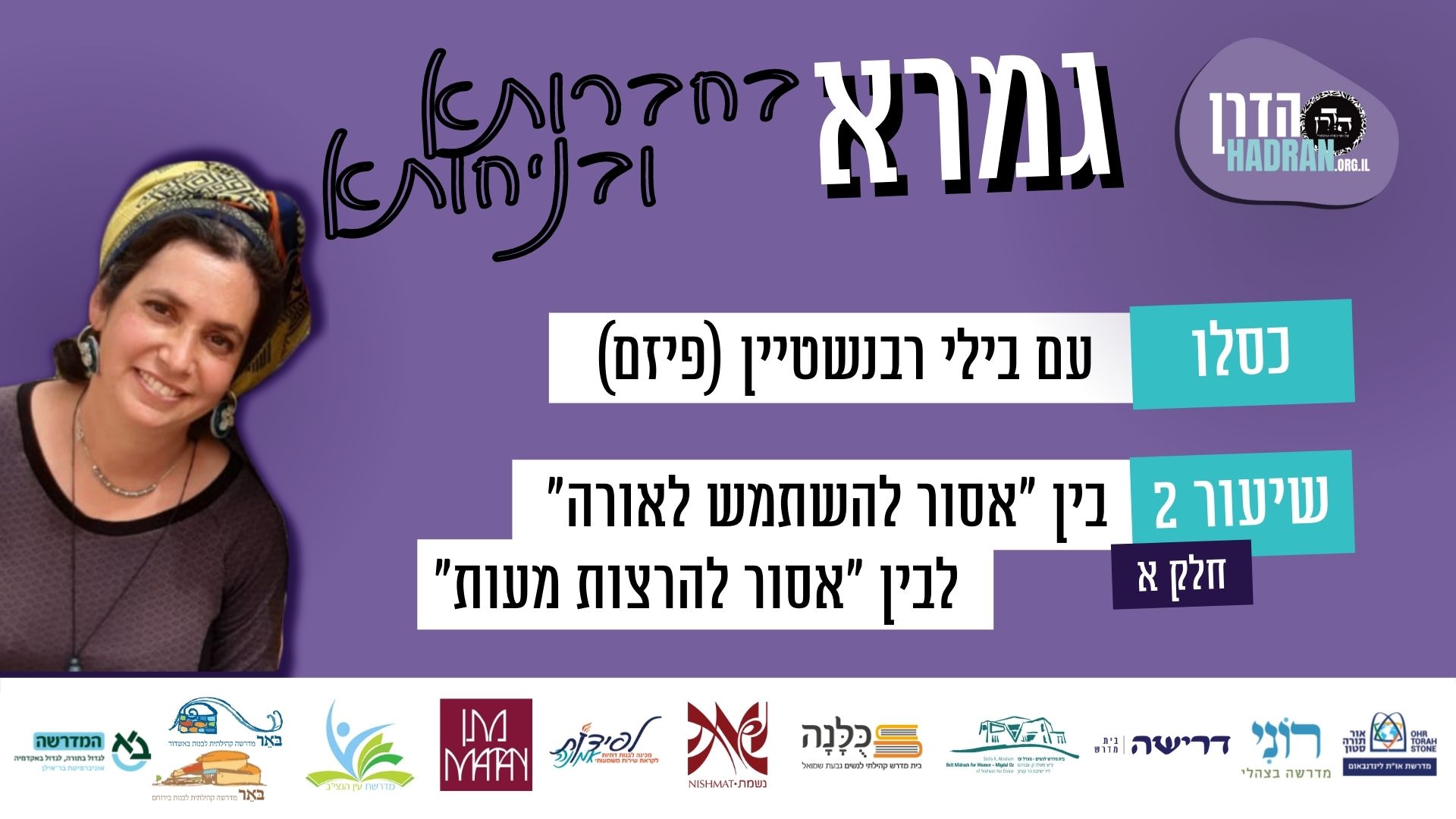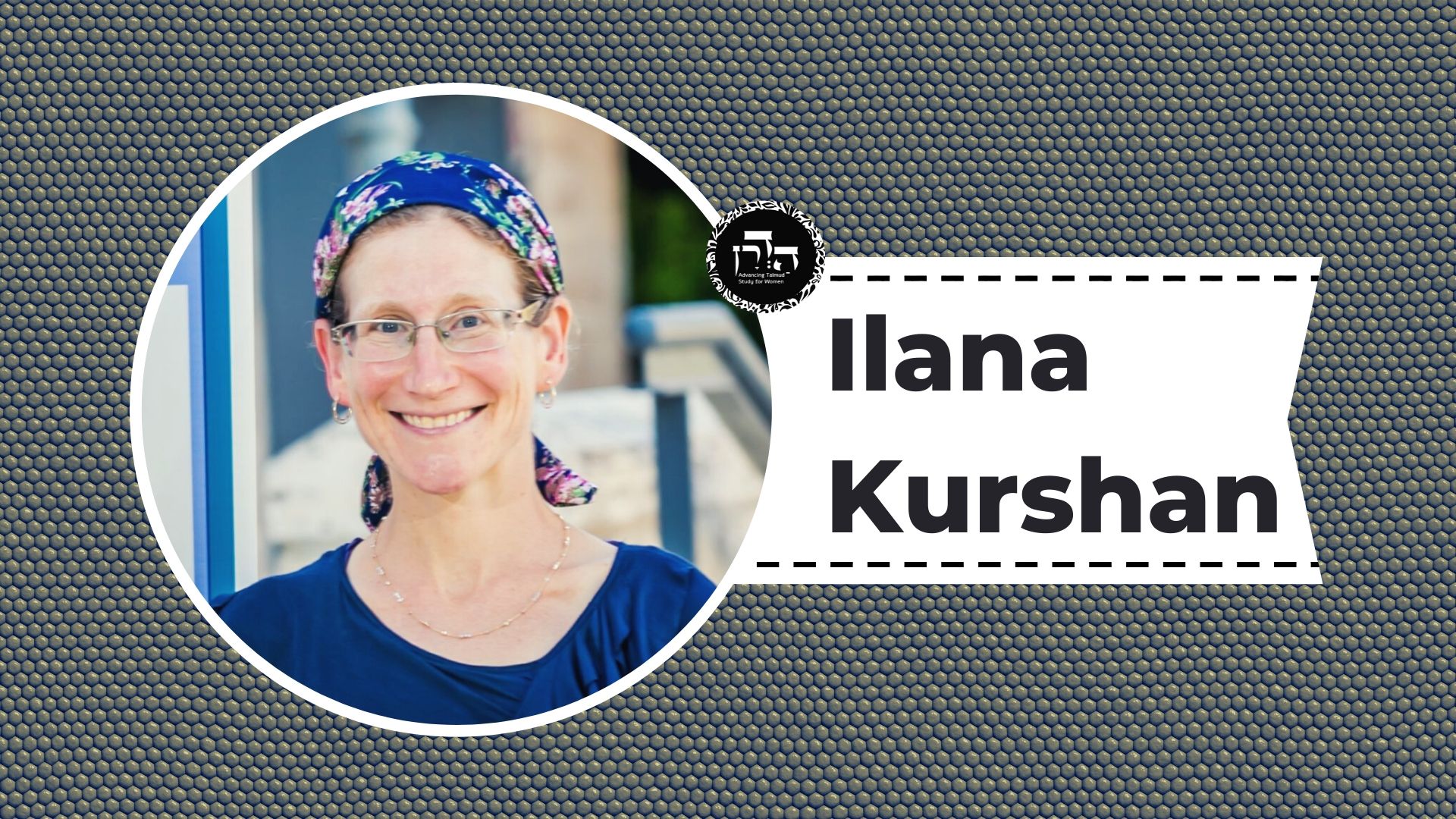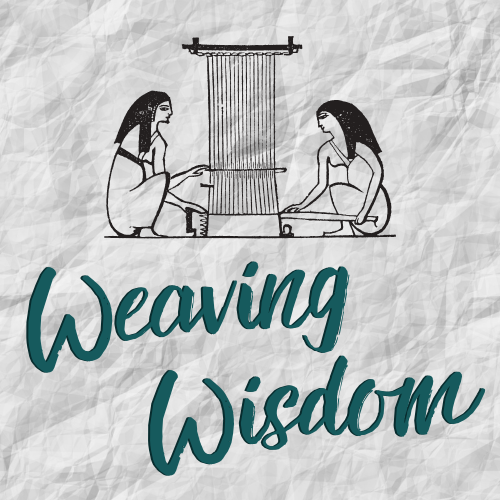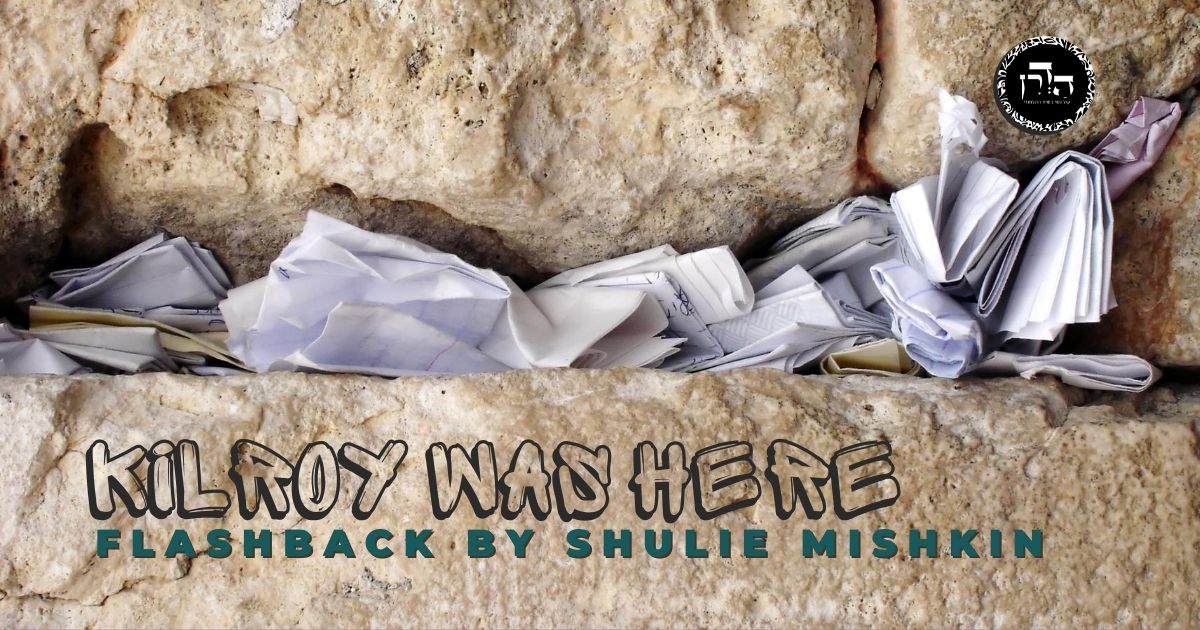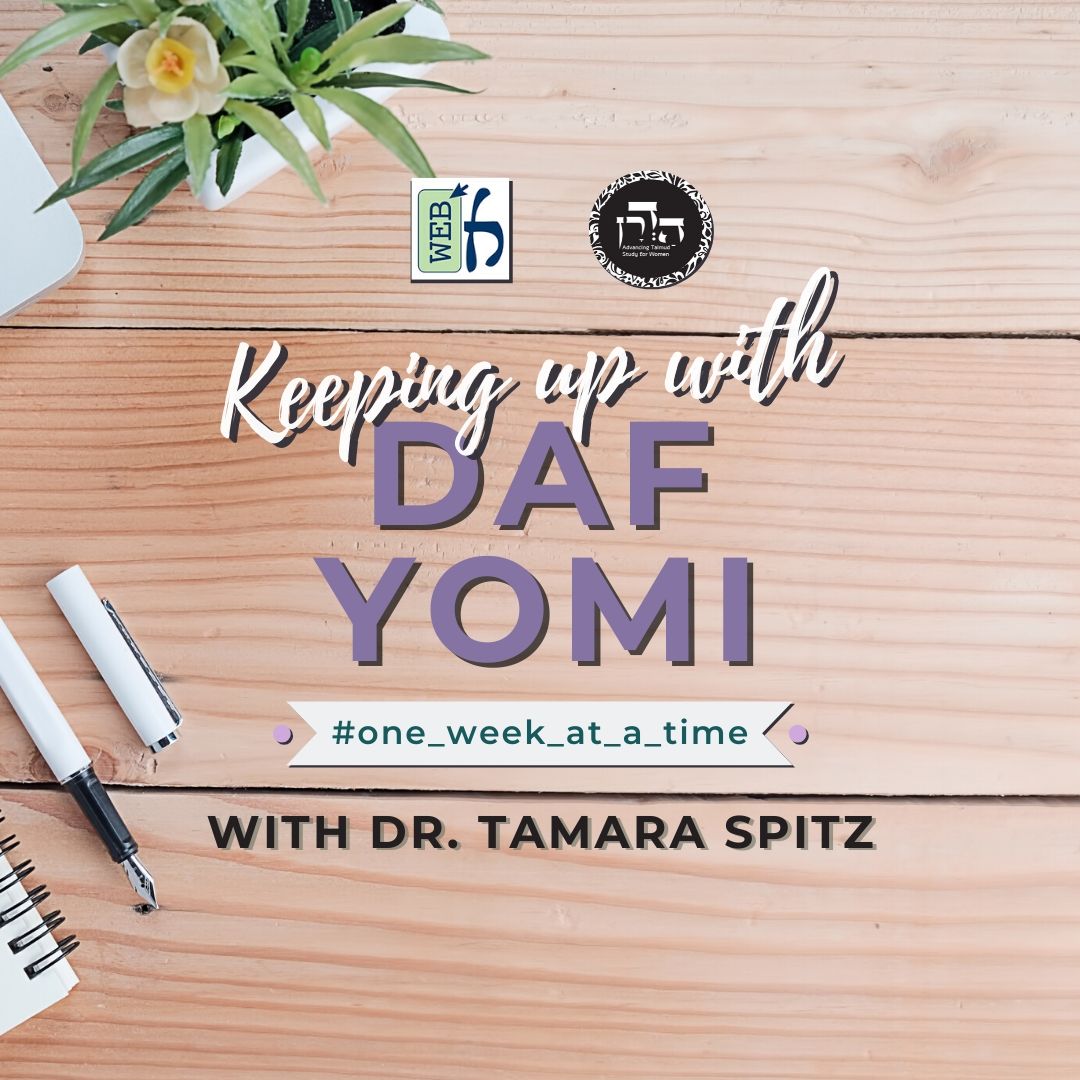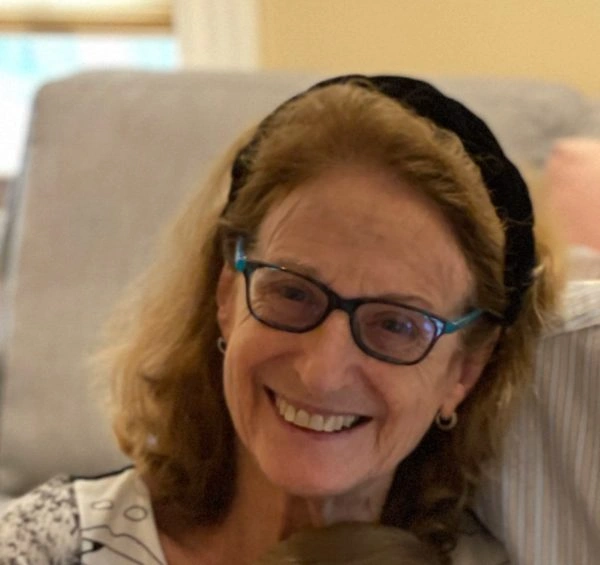In what cases can one move things that are muktze indirectly? When one comes out of a river on Shabbat, one needs to worry about carrying water that is on one’s body and therefore should dry off before walking. How can one clean off dirt off one’s foot on Shabbat? How can one clean dirt off one’s clothing? Can one scrape dirt off a shoe? Can one remove a shoe from the shoe frame? Why can’t a child go out with shoes that are too big or a woman wearing shoes she has never worn before? Can one carry a child if the child is carrying a rock in its hand? The mishna discusses cases where an item can be considered secondary to another and therefore will be able to be carried together with it and is not considered muktze. The gemara brings up cases regarding carrying from a public to private domain a child with a purse around its neck. The conclusion there is different from the mishna as there we obligate one for carrying the purse. Why the difference?
Want to dedicate learning? Get started here:
Today’s daily daf tools:
Delve Deeper
Broaden your understanding of the topics on this daf with classes and podcasts from top women Talmud scholars.
New to Talmud?
Check out our resources designed to help you navigate a page of Talmud – and study at the pace, level and style that fits you.
The Hadran Women’s Tapestry
Meet the diverse women learning Gemara at Hadran and hear their stories.
Shabbat 141
דְּאִית לַהּ רִירֵי.
which has spittle.
וְהָא דְּקָתָנֵי ״נוֹטְלִין מִלִּפְנֵי בְּהֵמָה שֶׁפִּיהָ רַע״ — בַּחֲמוֹר, דְּלָא דָּיֵיק וְאָכֵיל. ״וְנוֹתְנִין לִפְנֵי בְּהֵמָה שֶׁפִּיהָ יָפֶה״ — בְּפָרָה, דְּדָיְיקָא וְאָכְלָה.
And that which was taught in the other baraita: One may take hay from before an animal whose mouth is foul, is referring to a donkey. Its mouth is foul because it does not discern between different foods and it eats everything. And the statement: One may place it before an animal whose mouth is fine, is referring to a cow, which discerns between different foods and only then it eats.
מַתְנִי׳ הַקַּשׁ שֶׁעַל גַּבֵּי הַמִּטָּה — לֹא יְנַעְנְעֶנּוּ בְּיָדוֹ, אֶלָּא מְנַעַנְעוֹ בְּגוּפוֹ. וְאִם הָיָה מַאֲכַל בְּהֵמָה, אוֹ שֶׁהָיָה עָלָיו כַּר אוֹ סָדִין — מְנַעַנְעוֹ בְּיָדוֹ.
MISHNA: With regard to straw that is on top of a bed, if a person wishes to lie on it, he may not move it with his hand to smooth it, as the straw is set aside for kindling; rather, he may move it with his body. Since moving straw with one’s body is not the usual manner, it is permitted. And if the straw was designated as animal food, or a pillow or sheet was on it, which would clearly indicate that the straw was placed on the bed so one could sleep on it, the straw is not considered set-aside, and one may move it even with his hand.
מַכְבֵּשׁ שֶׁל בַּעֲלֵי בָתִּים — מַתִּירִין, אֲבָל לֹא כּוֹבְשִׁין. וְשֶׁל כּוֹבְסִין — לֹא יִגַּע בּוֹ. רַבִּי יְהוּדָה אוֹמֵר: אִם הָיָה מוּתָּר מֵעֶרֶב שַׁבָּת — מַתִּיר אֶת כּוּלּוֹ וְשׁוֹמְטוֹ.
A press which belongs to a homeowner, one may loosen it on Shabbat. This press is used to dry and press clothing after laundering. One loosens it to remove clothing from it. However, one may not press clothing with it on Shabbat. And in the case of a press that belongs to a launderer, which is made specifically for pressing and requires professional expertise for its operation, one may not touch it. Rabbi Yehuda says: If the launderer’s press was loosened somewhat on Shabbat eve, he may loosen it completely on Shabbat and remove the garment.
גְּמָ׳ אָמַר רַב נַחְמָן: הַאי פּוּגְלָא, מִלְּמַעְלָה לְמַטָּה — שְׁרֵי. מִלְּמַטָּה לְמַעְלָה — אֲסִיר.
GEMARA: With regard to moving items that are set aside, the Gemara cites that which Rav Naḥman said: This radish, which was buried in the earth, if it was buried from top to bottom, with its wide end at the top and its narrow end at the bottom, it is permitted to remove it on Shabbat. When the radish is buried in that manner, one does not move the earth when he removes the radish. However, if the radish was buried in the earth from bottom to top, with the wide end at the bottom, it is prohibited.
אָמַר רַב אַדָּא בַּר אַבָּא, אָמְרִי בֵּי רַב: תְּנֵינָא דְּלָא כְּרַב נַחְמָן. הַקַּשׁ שֶׁעַל גַּבֵּי הַמִּטָּה — לֹא יְנַעַנְעֶנּוּ בְּיָדוֹ, אֲבָל מְנַעַנְעוֹ בְּגוּפוֹ. וְאִם הָיָה מַאֲכַל בְּהֵמָה, אוֹ שֶׁהָיָה עָלָיו כַּר אוֹ סָדִין — מְנַעַנְעוֹ בְּיָדוֹ. שְׁמַע מִינַּהּ טִלְטוּל מִן הַצַּד — לָא שְׁמֵיהּ טִלְטוּל. שְׁמַע מִינַּהּ.
Rav Adda bar Abba said: They say in the school of Rav: We already learned in the mishna that the halakha is not in accordance with the opinion of Rav Naḥman: With regard to straw on top of a bed, one may not move it with his hand, but he may move it with his body. And if it is animal food, or a pillow or sheet is on it, he may move it even with his hand. Conclude from here that moving an item in an atypical manner is not considered moving. The Gemara concludes: Indeed, conclude from here that this is indeed the case.
אָמַר רַב יְהוּדָה: הָנֵי פִּלְפְּלֵי, מֵידַק חֲדָא חֲדָא בְּקַתָּא דְסַכִּינָא — שְׁרֵי, תַּרְתֵּי — אֲסִיר. רָבָא אָמַר: כֵּיוָן דִּמְשַׁנֵּי — אֲפִילּוּ טוּבָא נָמֵי.
The Gemara cites a somewhat similar case. Rav Yehuda said: In the case of these peppers, crushing them one by one with the handle of a knife is permitted. However, crushing two at a time is prohibited, because it appears to be a prohibited labor. Rava said: Since he alters the manner in which he performs this activity, even crushing many at a time is also permitted.
אָמַר רַב יְהוּדָה: מַאן דְּסָחֵי בְּמַיָּא — לִינַגֵּיב נַפְשֵׁיהּ בְּרֵישָׁא וַהֲדַר לִיסְלֵיק, דִילְמָא אָתֵי לְאֵתוֹיֵי אַרְבַּע אַמּוֹת בְּכַרְמְלִית.
Rav Yehuda also said: One who bathes in water should first dry himself immediately upon exiting, and then ascend to the coast, lest he come to carry the remaining drops of water on his body four cubits in a karmelit.
אִי הָכִי, כִּי קָא נָחֵית נָמֵי, קָא דָּחֵי כֹּחוֹ אַרְבַּע אַמּוֹת, וַאֲסִיר! כֹּחוֹ בְּכַרְמְלִית — לָא גְזַרוּ.
The Gemara asks: If so, if there is a concern about carrying water, there should be concern when one descends into the water as well. In that case, his force propels water four cubits into the river, and it should be prohibited. The Gemara answers: With regard to movement that results from his force in a karmelit, the Sages did not issue a decree. Since one does not directly propel the water, but the water moves only as an extension of his motion, and since the river is a karmelit, and the prohibition to carry there is only a rabbinic law, the Sages did not issue a decree for one who descends into the water.
אָמַר אַבָּיֵי, וְאִיתֵּימָא רַב יְהוּדָה: טִיט שֶׁעַל גַּבֵּי רַגְלוֹ — מְקַנְּחוֹ בַּקַּרְקַע, וְאֵין מְקַנְּחוֹ בַּכּוֹתֶל.
In a similar decree, Abaye said, and some say that it was stated by Rav Yehuda: If one has mud on his foot, he may wipe it on the ground on Shabbat, but he may not wipe it on a wall.
אָמַר רָבָא: מַאי טַעְמָא בַּכּוֹתֶל לָא, מִשּׁוּם דְּמֶיחְזֵי כְּבוֹנֶה? הָא בִּנְיָן חַקְלָאָה הוּא!
Rava said: What is the reason that he may not wipe it off on a wall? Is it because it appears like building, as he is adding plaster to the wall? That is the building of a field laborer, which is not an actual building. There is no concern in that case because in adding plaster to that building, one does not perform the prohibited labor of building.
אֶלָּא אָמַר רָבָא: מְקַנְּחוֹ בַּכּוֹתֶל וְאֵין מְקַנְּחוֹ בַּקַּרְקַע — דִּילְמָא אָתֵי לְאַשְׁווֹיֵי גּוּמּוֹת.
Rather, Rava said: On the contrary, He may wipe it on a wall, but he may not wipe it on the ground. This is due to the concern lest one come to level holes in the ground while wiping his foot.
אִיתְּמַר. מָר בְּרֵיהּ דְּרָבִינָא אָמַר: אֶחָד זֶה וְאֶחָד זֶה — אָסוּר. רַב פָּפָּא אָמַר: אֶחָד זֶה וְאֶחָד זֶה — מוּתָּר.
It is stated that other amora’im disputed this issue. Mar, son of Ravina, said: Both this, wiping the mud on a wall, and that, wiping the mud on the ground, are prohibited. Rav Pappa said: Both this and that are permitted.
לְמָר בְּרֵיהּ דְּרָבִינָא בְּמַאי מְקַנְּחִי לֵיהּ? מְקַנְּחִי לֵיהּ בְּקוֹרָה.
The Gemara asks: According to the opinion of Mar, son of Ravina, with what may he wipe his foot? The Gemara answers: Even according to his opinion, there is a permitted manner to clean his foot; he wipes it on a beam on the ground.
אָמַר רָבָא: לָא לִיתִּיב אִינִישׁ אַפּוּמֵּיהּ דְּלִיחְיָיא, דִילְמָא מִיגַּנְדְּרָא לֵיהּ חֵפֶץ וְאָתֵי לְאֵתוֹיֵי.
Rava said: A person should not sit on Shabbat right at the entrance to a closed alleyway where a side post is placed as a symbolic partition enabling one to carry inside the alleyway. The reason for this is that perhaps an object will roll into the public domain and one will come to get it, as there is no conspicuous demarcation between inside and outside the alleyway.
וְאָמַר רָבָא: לָא לִיצַדֵּד אִינִישׁ כּוּבָּא, דִּילְמָא אָתֵי לְאַשְׁווֹיֵי גּוּמּוֹת.
And Rava also said a similar decree: A person may not position a barrel on a dirt floor, lest he come to level holes in the ground while smoothing the surface upon which he is positioning the barrel.
וְאָמַר רָבָא: לָא לִיהַדֵּק אִינִישׁ אוּדְרָא בְּפוּמָּא דְשִׁישָׁא, דִילְמָא אָתֵי לִידֵי סְחִיטָה.
And furthermore, Rava said: A person may not stuff a rag into the mouth of a jug [shisha] on Shabbat, lest he come to violate the prohibition of squeezing liquid from the cloth.
אָמַר רַב כָּהֲנָא: טִיט שֶׁעַל גַּבֵּי בִּגְדּוֹ — מְכַסְכְּסוֹ מִבִּפְנִים וְאֵין מְכַסְכְּסוֹ מִבַּחוּץ.
Rav Kahana said: With regard to mortar that is on one’s garment on Shabbat, one may rub it off from the inside, but one may not rub it off from the outside, because that is comparable to the prohibited labor of laundering.
מֵיתִיבִי: טִיט שֶׁעַל גַּבֵּי מִנְעָלוֹ — מְגָרְרוֹ בְּגַב סַכִּין, וְשֶׁעַל בִּגְדּוֹ — מְגָרְרוֹ בְּצִפּוֹרֶן, וּבִלְבַד שֶׁלֹּא יְכַסְכֵּס. מַאי לָאו, שֶׁלֹּא יְכַסְכֵּס כְּלָל! לָא שֶׁלֹּא יְכַסְכֵּס מִבַּחוּץ, אֶלָּא מִבִּפְנִים.
The Gemara raises an objection from that which we learned: With regard to mortar that is on one’s shoe, he may scrape it off with the back of a knife as a departure from the typical manner of scraping. And mortar which is on one’s clothes, he may scrape off with his fingernail, as long as he does not rub it. The Gemara asks: What, is it not saying that he may not rub it at all? The Gemara rejects that premise: No, it is saying that he may not rub it from the outside, rather from the inside.
אָמַר רַבִּי אֲבָהוּ אָמַר רַבִּי אֶלְעָזָר אָמַר רַבִּי יַנַּאי: מְגָרְרִין מִנְעָל חָדָשׁ, אֲבָל לֹא יָשָׁן.
Rabbi Abbahu said that Rabbi Elazar said that Rabbi Yannai said: One may scrape mud off of a new shoe on Shabbat, but not off of an old shoe, because a layer of the shoe will be removed, which constitutes the prohibited labor of smoothing.
בַּמֶּה מְגָרְרוֹ? אָמַר רַבִּי אֲבָהוּ: בְּגַב סַכִּין.
With what does one scrape it off? Rabbi Abahu said: With the back of a knife, which is a departure from the typical manner of doing so.
אֲמַר לֵיהּ הָהוּא סָבָא: סְמִי דִּידָךְ מִקַּמֵּי הָא דְתָנֵי רַבִּי חִיָּיא: אֵין מְגָרְרִין לֹא מִנְעָל חָדָשׁ וְלֹא מִנְעָל יָשָׁן, וְלֹא יָסוּךְ אֶת רַגְלוֹ שֶׁמֶן וְהוּא בְּתוֹךְ הַמִּנְעָל אוֹ בְּתוֹךְ הַסַּנְדָּל. אֲבָל סָךְ אֶת רַגְלוֹ שֶׁמֶן, וּמַנִּיחַ בְּתוֹךְ הַמִּנְעָל אוֹ בְּתוֹךְ הַסַּנְדָּל. וְסָךְ כׇּל גּוּפוֹ שֶׁמֶן, וּמִתְעַגֵּל עַל גַּבֵּי קַטְבֻלְיָא, וְאֵינוֹ חוֹשֵׁשׁ.
A certain Elder said to Rabbi Abbahu: Delete your teaching before this statement taught by Rabbi Ḥiyya: One may not scrape at all; neither a new shoe nor an old shoe, and one may not smear oil on one’s foot while it is inside the shoe or inside the sandal, as the oil is absorbed by the leather of the shoe and strengthens it, which constitutes performance of the prohibited labor of tanning. However, one may smear oil on his foot in the typical manner and place it afterward in a shoe or in a sandal, and he need not be concerned that this oil will enhance the shoe leather. And he may likewise smear oil on his entire body with oil and roll on a leather carpet, and he need not be concerned.
אָמַר רַב חִסְדָּא: לֹא שָׁנוּ אֶלָּא לְצַחְצְחוֹ, אֲבָל לְעַבְּדוֹ — אָסוּר.
Rav Ḥisda said: They only taught this in a case where he does so in order to polish the carpet. But if he does so to tan the carpet, it is prohibited.
לְעַבְּדוֹ, פְּשִׁיטָא? וְתוּ: לְצַחְצְחוֹ, מִי אִיכָּא מַאן דְּשָׁרֵי?
The Gemara raises a difficulty: If he does so to tan the leather, it is obvious that it is prohibited, as tanning is a labor prohibited by Torah law. And furthermore: If he does so in order to polish it, is there an opinion that permits one to perform this act intentionally on Shabbat ab initio?
אֶלָּא, אִי אִיתְּמַר הָכִי אִיתְּמַר: אָמַר רַב חִסְדָּא, לֹא שָׁנוּ אֶלָּא שִׁיעוּר לְצַחְצְחוֹ, אֲבָל שִׁיעוּר לְעַבְּדוֹ — אָסוּר.
Rather, if it was stated, it was stated as follows: Rav Ḥisda said: They only taught that it is permitted to do so on Shabbat in a case where one smears a measure sufficient only to polish it; however, if one smears a measure sufficient to tan it, it is prohibited, even if he did not intend to tan the leather.
תָּנוּ רַבָּנַן: לֹא יֵצֵא קָטָן בְּמִנְעָל גָּדוֹל, אֲבָל יוֹצֵא הוּא בְּחָלוּק גָּדוֹל.
The Sages taught in a baraita: A small person may not go out in a too large shoe, due to concern lest the shoe fall off and he will come to carry it in the public domain; but he may go out in a too large cloak. Even if it does not fit him properly, it will certainly not fall off.
וְלֹא תֵּצֵא אִשָּׁה בְּמִנְעָל מְרוּפָּט, וְלֹא תַּחֲלוֹץ בּוֹ, וְאִם חָלְצָה — חֲלִיצָתָהּ כְּשֵׁרָה.
And a woman may not go out on Shabbat in a shoe that is torn on top, lest she be mocked, remove it, and carry it on Shabbat. And a shoe of that kind may not be used to perform ḥalitza, as it is not a suitable shoe. Ḥalitza is performed by a widow bound in a levirate bond with her brother-in-law. However, if she performed ḥalitza with it, her ḥalitza is valid, since ultimately it is a shoe.
וְאֵין יוֹצְאִין בְּמִנְעָל חָדָשׁ. בְּאֵיזֶה מִנְעָל אָמְרוּ — בְּמִנְעָל שֶׁל אִשָּׁה.
And one may not go out on Shabbat wearing a new shoe, due to the concern that it will not fit properly, and then one will remove it and carry it. The Gemara comments: In what case did they say that one may not wear a new shoe? They said this with regard to a woman’s shoe, as women are very particular about having their shoes fit properly.
תָּנֵי בַּר קַפָּרָא: לֹא שָׁנוּ אֶלָּא שֶׁלֹּא יָצְאָה בּוֹ שָׁעָה אַחַת מִבְּעוֹד יוֹם, אֲבָל יָצְאָה בּוֹ מֵעֶרֶב שַׁבָּת — מוּתָּר.
Bar Kappara taught: They only taught that she may not go out wearing a new shoe on Shabbat if she did not yet go out wearing it for any length of time while it was still day. However, if she went out wearing it on Shabbat eve, at which point she would have ascertained if it fits her, she is permitted to go out wearing it on Shabbat.
תָּנֵי חֲדָא: שׁוֹמְטִין מִנְעָל מֵעַל גַּבֵּי אֵימוּס, וְתַנְיָא אִידַּךְ: אֵין שׁוֹמְטִין. לָא קַשְׁיָא: הָא — רַבִּי אֱלִיעֶזֶר, הָא — רַבָּנַן.
One baraita taught: One may remove a shoe from the shoemaker’s last, the frame on which a shoe is shaped, on Shabbat. And another baraita taught the opposite: One may not remove it. The Gemara explains that this is not difficult: This baraita, which prohibits doing so, is in accordance with the opinion of Rabbi Eliezer, and that baraita, which permits doing so, is in accordance with the opinion of the Rabbis. Rabbi Eliezer and the Rabbis dispute the applicability of the halakhot of ritual purity and impurity in a similar case.
דִּתְנַן: מִנְעָל שֶׁעַל גַּבֵּי אֵימוּס, רַבִּי אֱלִיעֶזֶר מְטַהֵר, וַחֲכָמִים מְטַמְּאִים.
As we learned in a mishna: A shoe that remains on a last, Rabbi Eliezer deems it pure, i.e., unable to become impure, as in his opinion the shoe is not yet complete, and therefore it is not yet a vessel and cannot become impure. And the Rabbis deem it capable of becoming impure, as in their opinion, the shoe is completed, and any vessel whose work is complete can become ritually impure. Correspondingly, the Rabbis, who hold that a shoe on a last is a completed vessel, hold that it may be moved on Shabbat. Rabbi Eliezer, who holds that it is an incomplete vessel, holds that it may not be moved.
הָנִיחָא לְרָבָא, דְּאָמַר: דָּבָר שֶׁמְּלַאכְתּוֹ לְאִיסּוּר, בֵּין לְצוֹרֶךְ גּוּפוֹ, בֵּין לְצוֹרֶךְ מְקוֹמוֹ — מוּתָּר, שַׁפִּיר.
The Gemara poses a question: It works out well according to the opinion of Rava, who said: Moving an object whose primary function is for a prohibited use, whether for the purpose of utilizing the object itself to perform a permitted action or for the purpose of utilizing its place, is permitted. It is well understood that one may move the last slightly while removing the shoe, since removing the shoe is considered utilizing the last’s place.
אֶלָּא לְאַבָּיֵי, דְּאָמַר: לְצוֹרֶךְ גּוּפוֹ — מוּתָּר, לְצוֹרֶךְ מְקוֹמוֹ — אָסוּר. מַאי אִיכָּא לְמֵימַר?
However, according to Abaye, who said that for the purpose of utilizing the object itself to perform a permitted action, it is permitted; however, for the purpose of utilizing its place, it is prohibited, what can be said? It is prohibited to move the last, which is clearly a utensil whose primary function is for a prohibited use. How is it possible to remove the shoe without moving the last?
הָכָא בְּמַאי עָסְקִינַן — בְּרָפוּי. דְּתַנְיָא, רַבִּי יְהוּדָה אוֹמֵר: אִם הָיָה רָפוּי — מוּתָּר.
The Gemara answers: With what are we dealing here? It is with a shoe placed loosely on the last, so the shoe can be removed without moving the last. As it was taught in a baraita: Rabbi Yehuda says: If it was loose, it is permitted.
טַעְמָא דְּרָפוּי, הָא לֹא רָפוּי — לָא. הָנִיחָא לְאַבָּיֵי, דְּאָמַר: דָּבָר שֶׁמְּלַאכְתּוֹ לְאִיסּוּר, לְצוֹרֶךְ גּוּפוֹ — מוּתָּר, לְצוֹרֶךְ מְקוֹמוֹ — אָסוּר, שַׁפִּיר.
The Gemara infers: The reason it is permitted is only because it is loose; however, if it is not loose, no, it is prohibited. It works out well according to the opinion of Abaye, who said that moving an object whose primary function is for a prohibited use for the purpose of utilizing the object itself to perform a permitted action it is permitted; however, for the purpose of utilizing its place, it is prohibited to move it. It is well understood that it is prohibited to move the last if the shoe is tightly attached to it.
אֶלָּא לְרָבָא, דְּאָמַר: בֵּין לְצוֹרֶךְ גּוּפוֹ, בֵּין לְצוֹרֶךְ מְקוֹמוֹ — מוּתָּר, מַאי אִירְיָא רָפוּי? אֲפִילּוּ לֹא רָפוּי נָמֵי!
However, according to Rava, who said that moving an object whose primary function is for a prohibited use, whether for the purpose of utilizing the object itself to perform a permitted action or for the purpose of utilizing its place, is permitted, why discuss specifically a case where it is loose? Even if it were not loose, it should also be permitted to move it.
דְּרַבִּי יְהוּדָה מִשּׁוּם דְּרַבִּי אֱלִיעֶזֶר הוּא. דְּתַנְיָא, רַבִּי יְהוּדָה אוֹמֵר מִשּׁוּם רַבִּי אֱלִיעֶזֶר: אִם הָיָה רָפוּי — מוּתָּר.
The Gemara answers: That baraita is the opinion of Rabbi Yehuda in the name of Rabbi Eliezer, and it is not a clarification of the opinion of the Rabbis. Although Rabbi Eliezer holds that the shoe is not yet completed, nevertheless, Rabbi Yehuda says in the name of Rabbi Eliezer that it is permitted to carry it. As it was taught in a baraita: Rabbi Yehuda says in the name of Rabbi Eliezer: If it was already loose and no longer requires a last, it is permitted to move it, since it is a completed vessel and no longer needs the last to shape it.
הדרן עלך תולין
מַתְנִי׳ נוֹטֵל אָדָם אֶת בְּנוֹ וְהָאֶבֶן בְּיָדוֹ. וְכַלְכַּלָּה וְהָאֶבֶן בְּתוֹכָהּ. וּמְטַלְטְלִין תְּרוּמָה טְמֵאָה עִם הַטְּהוֹרָה, וְעִם הַחוּלִּין.
MISHNA: A person may take his son in his hands on Shabbat, and even though there is a stone, which is a set-aside item, in the child’s hand, it is not prohibited to pick up the child. And it is permissible to take a basket with a stone inside it on Shabbat. And one may move ritually impure teruma, which may not be eaten and is set-aside, with ritually pure teruma, as well as with non-sacred produce.
רַבִּי יְהוּדָה אוֹמֵר: אַף מַעֲלִין אֶת הַמְדוּמָּע בְּאֶחָד וּמֵאָה.
Rabbi Yehuda says: One may even lift a measure of teruma that was nullified from a mixture of one hundred measures of non-sacred produce and one measure of teruma. When a measure of teruma is mixed with non-sacred produce, if the non-sacred produce is one hundred times the measure of teruma, the teruma is nullified. However, the Sages instituted that one must remove an amount equivalent to that measure of teruma and give it to a priest. The remainder is considered non-sacred produce. Rabbi Yehuda permits removing that measure on Shabbat to render the mixture permitted to eat.
גְּמָ׳ אָמַר רָבָא: הוֹצִיא תִּינוֹק חַי וְכִיס תָּלוּי בְּצַוָּארוֹ — חַיָּיב מִשּׁוּם כִּיס. תִּינוֹק מֵת וְכִיס תָּלוּי לוֹ בְּצַוָּארוֹ — פָּטוּר.
GEMARA: Rava said: If one carried out a living baby to the public domain on Shabbat, and the baby had a purse that was hanging around his neck, he is liable for carrying out the purse. However, one who carried out a dead baby, with a purse hanging around his neck, is exempt.
תִּינוֹק חַי וְכִיס תָּלוּי לוֹ בְּצַוָּארוֹ — חַיָּיב מִשּׁוּם כִּיס: וְלִיחַיַּיב נָמֵי מִשּׁוּם תִּינוֹק!
Rava said: If one carried out a living baby to the public domain on Shabbat, and a purse was hanging around the baby’s neck, he is liable for carrying out the purse. The Gemara asks: And let him be liable for carrying out the baby as well.
רָבָא כְּרַבִּי נָתָן סְבִירָא לֵיהּ, דְּאָמַר חַי נוֹשֵׂא אֶת עַצְמוֹ.
The Gemara responds: Rava holds in accordance with the opinion of Rabbi Natan, who said: A living being carries itself. Therefore, one who carries a living being from one domain to another is not liable.
וְלִיבְטַל כִּיס לְגַבֵּי תִּינוֹק, מִי לָא תְּנַן אֶת הַחַי בַּמִּטָּה — פָּטוּר אַף עַל הַמִּטָּה, שֶׁהַמִּטָּה טְפֵילָה לוֹ?
The Gemara asks: And let the purse be negated relative to the baby; and he should be exempt for carrying out the purse as well. Didn’t we learn in a mishna: One who carries out a living person on a bed is exempt even for carrying out the bed, because the bed is secondary to the person? The same should be said with regard to the purse, relative to the baby.
מִטָּה לְגַבֵּי חַי — מְבַטְּלִי לֵיהּ, כִּיס לְגַבֵּי תִּינוֹק — לָא מְבַטְּלִי לֵיהּ.
The Gemara answers: In a case where a bed is relative to a living being, the living being negates it, as the bed is needed to carry the person and is secondary to him. However, in a case where a purse is relative to a baby, the baby does not negate it, since it is independently significant.
תִּינוֹק מֵת וְכִיס תָּלוּי לוֹ בְּצַוָּארוֹ — פָּטוּר: וְלִיחַיַּיב מִשּׁוּם תִּינוֹק! רָבָא כְּרַבִּי שִׁמְעוֹן סְבִירָא לֵיהּ דְּאָמַר: כׇּל מְלָאכָה שֶׁאֵין צָרִיךְ לְגוּפָהּ — פָּטוּר עָלֶיהָ.
And Rava said: One who carried out a dead baby with a purse hanging around the baby’s neck is exempt. The Gemara asks: And let him be liable for carrying out the baby. The Gemara answers: Rava holds in accordance with the opinion of Rabbi Shimon, who said: With regard to any labor that is not needed for its own sake, one is exempt for performing it on Shabbat. One who carries out a corpse does not do so because he needs it; rather, he does so for the sake of the corpse, i.e., to bury it or to move it from a degrading place. Therefore, he has not performed a labor prohibited by Torah law. Similarly, he is also exempt for carrying out the purse because due to his distress and mourning he negates the purse, as it is insignificant relative to the baby.
תְּנַן: נוֹטֵל אָדָם אֶת בְּנוֹ וְהָאֶבֶן בְּיָדוֹ? אָמְרִי דְּבֵי רַבִּי יַנַּאי בְּתִינוֹק שֶׁיֵּשׁ לוֹ גַּעֲגוּעִין עַל אָבִיו.
We learned in the mishna: A person may take his son in his hands on Shabbat; and this is permitted even though there is a stone in the child’s hand. As it can be inferred from this mishna that the stone is negated relative to the child, why, then, is he liable in the case of a purse hanging around a live baby’s neck? Let the purse be negated relative to the baby. The Sages of the school of Rabbi Yannai say: You cannot infer from this mishna that the stone is negated and therefore it is permitted to move it. Rather, the mishna is referring to a baby who has longings for his father. It is permitted for the father to move the stone because if the father does not lift him, the baby might take ill.
אִי הָכִי,
The Gemara asks: If so,




